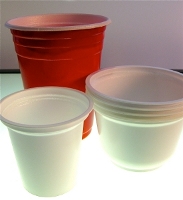
The oxygen permeation property of polystyrene makes it a viable choice for packaging certain dairy products.
Styron’s John Case, global marketing manager, provides his perspective on dairy developments in this exclusive interview withFood & Beverage Packaging.
What do you see as the current drivers-and those going forward-in dairy packaging?
The dairy packaging market will see four principal areas of importance merging in 2011. These must be viewed as interlinked, since together they form the future value proposition for dairy packaging:
• Continuing price pressure
• Product differentiation through packaging solutions to attract consumers, for example aesthetics and haptics
• The inclusion and demonstration of sustainability
• Desire for weight reduction (being a proxy for both cost and sustainability)
Plastics continue to be the most widely used material globally, offering us health, safety and peace of mind, and they will remain an integral part of our daily lives and our future.
Plastics will also continue to substitute for traditional packaging materials, offering many advantages seen in the four main areas of importance. Within the range of plastic packaging materials lies polystyrene, popular in rigid thin-wall applications and the material of choice for the dairy market. Some of polystyrene’s benefits include:
• High production speed capability and stiffness-the preferred polymer for both dairy and food service applications
• Oxygen permeability makes it the ideal polymer for maintaining freshness, including biologically active dairy products
• Versatility that allows a variety of packaging forms, from films to bottles, with excellent aesthetics.
This strong position in the market has been gained partly because PS has already helped brand owners seize the four opportunities listed above. However, innovations in PS resins continue to prosper. New developments in mechanical performance will allow up to 10% more downgauging, reducing both the material and energy consumption, thus decreasing the cost and carbon footprint of the packaging product.
You mention oxygen permeability: Could you elaborate on that?
Every (polymer) material has certain barrier properties against certain gases: its permeability for a given gas may be high, medium or low. Certain polymer families have higher-barrier properties/lower permeability versus certain gases. High barrier applications (e.g. long shelf-life ambient food packaging) use the low permeability/high barrier of a polymer such as ethylene vinyl alcohol (EVOH) to achieve this in coextruded structures with materials of lower barrier such as polyethylene, polypropylene, polyethylene terephthalate (PET) or PS.
PS has a significantly lower barrier properties/higher permeability towards oxygen when compared to PET. In some cases low barrier is undesired.
In other cases it is in fact preferred: in the case of biologically active dairy drinks, PS offers the required permeability to oxygen to preserve the quality and the taste of these products. PET does not offer sufficient permeability for these applications.In summary: PS has the right (optimal) level of permeability for dairy packaging applications, not too high and not too low.
How else does packaging impact these products and vice versa?
Brand owners are looking for packaging solutions that fulfill an increasing number of requirements. Next to health and safety, ease of consumption and minimal food spoilage are becoming more and more important. On top of that, the dairy market is also driven by production costs and reduction of raw material usage. As a result, to be successful in today’s market the choice and quality of packaging are core issues for dairy brand owners. Styron is confident that its innovative offerings allow brand owners to create new and exciting packaging for dairy products.
What expertise does Styron bring to this market?
At the end of 2010, Styron introducedCO2RE to the dairy market, a patented foaming technology for PS aimed at helping the packaging and foodservice industries reduce raw material consumption. Styron’s internal tests using CO2RE foaming technology illustrate significant density reductions of up to 20%. By reducing PS packaging density, CO2RE foaming technology results in lightweighting of packaging to benefit the entire value chain; converters use less raw material and energy to produce the packaging, while brand owners benefit from a lower packaging waste disposal tax. The technology opens new opportunities for product differentiation by offering different aesthetics and haptics.
What’s the market status of CO2RE?
REMA Industries and Services(RIS), a major Australian food packaging company, recently introduced CO2RE foaming technology on its extrusion lines after signing a license. From the offset of the project, Styron provided the company with the technical package and support to efficiently implement CO2RE foaming technology on its existing lines. The installation process began during the end of September 2010 and finished with successful product trials of the technology on its products by the end of October. The company is now fully equipped to produce foamed PS plates and cups.
According to RIS, “Introducing CO2RE technology into our products will not only benefit the company by giving us greater margins, but it will also benefit our customers through our ability to pass on a lot of the savings that we have been able to benefit from. It is going to be a win-win for ourselves and our customers.”
More recently, one of the largest and technically advanced form-fill-seal producers for dairy packaging signed a CO2RE license as well. Styron is currently helping to install the equipment for the start-up of production with CO2RE foaming technology.
-Rick Lingle, executive editor
